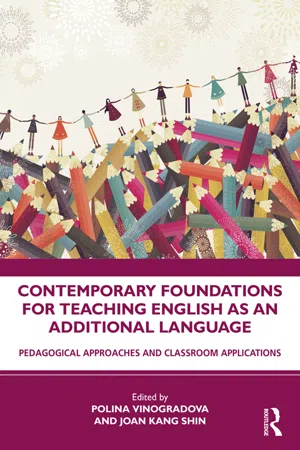
Contemporary Foundations for Teaching English as an Additional Language
Pedagogical Approaches and Classroom Applications
- 318 pages
- English
- ePUB (mobile friendly)
- Available on iOS & Android
Contemporary Foundations for Teaching English as an Additional Language
Pedagogical Approaches and Classroom Applications
About This Book
This engaging volume on English as an Additional Language (EAL), argues persuasively for the importance of critical participatory pedagogies that embrace multilingualism and multimodality in the field of TESOL. It highlights the role of the TESOL profession in teaching for social justice and advocacy and explores how critical participatory pedagogies translate into English language teaching and teacher education around the world.
Bringing together diverse scholars in the field and practicing English language teachers, editors Polina Vinogradova and Joan Kang Shin present 10 thematically organized units that demonstrate that language teaching pedagogy must be embedded in the larger sociocultural contexts of teaching and learning to be successful. Each unit covers one pedagogical approach and includes three case studies to illustrate how English language teachers across the world implement these approaches in their classrooms. The chapters are supplemented by discussion questions and a range of practical sources for further exploration. Addressing established and emerging areas of TESOL, topics covered include:
-
- Critical and postmethod pedagogies
-
- Translingualism
-
- Digital literacy and multiliteracies
-
- Culturally responsive pedagogy
-
- Advocacy
Featuring educators implementing innovative approaches in primary, secondary, and tertiary contexts across borders, Contemporary Foundations for Teaching English as an Additional Language is an ideal text for methods and foundational courses in TESOL and will appeal to in-service and preservice English language teachers as well as students and teacher educators in TESOL and applied linguistics.
Frequently asked questions
Information
UNIT 1
Introduction
CHAPTER 1
Introduction
FRAMING THE ISSUE
CONCEPTS AND THEORETICAL CONSIDERATIONS
Frameworks for 21st-Century Skills


- Creativity and Innovation
- Critical Thinking and Problem Solving
- Communication
- Collaboration
- Information Literacy
- Media Literacy
- ICT (Information, Communications, and Technology) Literacy
- Flexibility and Adaptability
- Initiative and Self-Direction
- Social and Cross-Cultural Skills
- Productivity and Accountability
- Leadership and Responsibility
- Empowered Learner: Students leverage technology to take an active role in choosing, achieving and demonstrating competency in their learning goals, informed by the learning sciences.
- Digital Citizen: Students recognize the rights, responsibilities and opportunities of living, learning and working in an interconnected digital world, and they act and model in ways that are safe, legal and ethical.
- Knowledge Constructor: Students critically curate a variety of resources using digital tools to construct knowledge, produce creative artifacts and make meaningful learning experiences for themselves and others.
- Innovative Designer: Students use a variety of technologies within a design process to identify and solve problems by creating new, useful or imaginative solutions.
- Computational Thinker: Students develop and employ strategies for understanding and solving problems in ways that leverage the power of technological methods to develop and test solutions.
- Creative Communicator: Students communicate clearly and express themselves creatively for a variety of purposes using...
Table of contents
- Cover
- Half Title
- Title Page
- Copyright Page
- Contents
- List of Figures
- List of Tables
- Foreword
- Preface
- Acknowledgments
- Unit 1 Introduction
- Unit 2 Critical Pedagogies and TESOL
- Unit 3 Postmethod Pedagogy in ELT
- Unit 4 Culturally Responsive Pedagogy in ELT
- Unit 5 Translingualism in TESOL
- Unit 6 Multiliteracies in TESOL
- Unit 7 Collaborative Technologies and TESOL
- Unit 8 Digital Literacy and TESOL
- Unit 9 Advocacy and TESOL
- Unit 10 TESOL Teacher Education
- Index